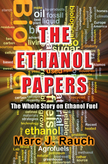Jalopnik Gets Slopnik on Ethanol Facts - SPECIAL UPDATE
 |
Egregiously Sloppy Commentary on Ethanol is Inexcusable
 Marc Rauch |
Author of THE ETHANOL PAPERS and YES, TIN LIZZIE WAS AN ALCOHOLIC
Exec. Vice President/Co-Publisher
THE AUTO CHANNEL
Jalopnik.com is a popular and oft-quoted website. The outlet features automotive and transportation stories of all sorts, similar to TheAutoChannel.com. Jalopnik has been online for about 20 years, and my own personal familiarity with the content presented on their website is that it's usually interesting, informative, and enjoyable.
On Sunday, June 6th, Jalopnik.com published a disappointing and unfortunate story about ethanol fuel: "Why Gasoline Has Ethanol, And How It Affects Your Engine." The story was presumably authored by Charles Krome.
 Charles Krome |
I call the story disappointing because the information is wrong; terribly wrong. I say it's unfortunate because if it's allowed to remain online then it will surely have a disastrous effect on the credibility of Jalopnik and its author. And, I question the authorship of the piece because it reads and appears as if it was generated by AI (artificial intelligence).
One of the reasons I say the story seems like it was AI generated is because the primary resource cited to support the information in the Jalopnik story is a 2024 video of John Oliver talking about corn and ethanol. For those who don't know who John Oliver is, or what his credentials are to expound on corn and ethanol, he is a British comedian who hosts a comedy show on the HBO network. Oliver is a "twit," which is a British term that's basically equivalent to "schmuck." He's not a technologically knowledgeable person to call on for any kind of scientific explanation. But, citing Oliver is the kind of frivolous reference that an AI program would latch on to simply because somewhere in a computer's databank, John Oliver's name frequently appears (frequency, and not credibility, is largely how and why information appears in any AI-generated text).
Just so you know, John Oliver is not the first comedy talk show host to try to tackle the subject of ethanol fuel. Greg Gufeld did so on his FoxNews show back in February 2022. Gutfeld's comments were also stupid, and although I am a big fan of Gutfeld's show, I published a harsh rebuttal at that time. You can read it by clicking HERE.
Putting aside my criticism of Greg Gutfeld's and John Oliver's very limited knowledge of ethanol fuel, let me proceed to the real purpose of this rebuttal, which is to rebut the stupid comments made in the Jalopnik story.
The first thing I did was to research Jalopnik.com and then Charles Krome for previous stories about ethanol fuel, in order to ascertain what level of knowledge they possess about the subject. I typed into the Google search box "Ethanol Stories on Jalopnik.Com." I then typed in "Ethanol Stories by Charles Krome." The search engine results revealed a vast paucity of any previous coverage.
By contrast, when I type into Google "Ethanol Stories on TheAutoChannel.com" and then "Ethanol Stories by Marc Rauch," the results show a near-endless number of articles, videos, and audio files that explain the truths about ethanol fuel.
In the Jalopnik article, Mr. Krome (or Mr. AI) shortcuts the history of ethanol (as well as other non-petroleum oil based fuels) by starting with Nicolaus Otto's first internal combustion engine in the late 1800s. Samuel Morey and others used alcohol-based fuels as early as the 1820s to power their internal combustion engine efforts. Henry Ford used alcohol-based fuels in his early automobiles in the late 1800s, and Rudolf Diesel used peanut/vegetable oil fuels in his "Diesel" engine. The article then jumps a generation to the 1920s and 1930s, which is alright if you're telling a truthful story about ethanol, but if you're trying to downplay what could have been, and should have been ethanol's use as the primary fuel for internal combustion engines, then it's not okay. There's a lot to the story that should be understood. Fortunately, I cover all this in my published report:
In skipping to the 1920s and 1930s, the Jalopnik article states that ethanol was:
- "... a popular performance-boosting additive to gasoline in the 1920s and
1930s."
There's truth in that statement, but ethanol's performance-boosting characteristics was known in America and around-the-world as early as the 1890s. Moreover, ethanol-gasoline blends were widely used in England and other parts of the world at the beginning of the 20th century onward. In Britain, for example, the two main purveyors of ethanol-gasoline blends for most of the 20th century were the American companies Esso and Cities Service. In Europe, these American companies promoted the ethanol-gasoline as the best fuel; being more powerful, cleaner, healthier, and more economical than any ethanol-free gasoline. At the same time in America, Esso and other former Standard Oil spin-off companies invented lies and myths to denigrate ethanol. You can read all about this in two of my published reports:
-
• The Rise & Fall of General Motors and the
Subjugation of the Industrialized World
• The Hypocrisy of Big Oil
Moving on, the Jalopnik article makes reference to questionable environmental benefits, stating:
-
"... ethanol can burn cleaner and more completely than gasoline, leaving behind fewer greenhouse gases to contribute to air pollution. Still, things get a little murky when
you try to look at the big picture. Some scientists say that if you also take into account emissions produced by transforming corn into ethanol, the fuel ends up making more
emissions than gasoline."
The scientists that the article refers to, even if no one at Jalopnik knows this, are people such as David Pimentel, Tad Patzek, Tim Searchinger, Tyler Lark and a whole collection of academic poseurs whose work was sponsored by the oil industry.
 |
The Jalopnik article does provide some comic relief in a paragraph that reads:
- "...most ethanol is derived from corn, which is relatively easy to regrow and renew. You can't
farm a crop of gasoline by planting old dinosaurs, although you can't feed hungry people with corn turned into ethanol, either."
The joke, however, is on whoever or whatever (AI program) concocted this statement. Petroleum oil does not come from dinosaurs or any other deceased living organisms, and the corn used to make ethanol does help to feed hungry people. You see, the very same corn kernels that are used to make ethanol are also used to make high-protein food for animals that people eat. So, with corn, there's more fuel and more food. In addition, the Distillers Dried Grains (DDGS) are now also being used as a high protein food for household pets (that don't get eaten, except in China).
I hope you're sensing a pattern here, that this Jalopnik article is bovine manure. But, don't go away because the best is yet to come.
At this point, the idiotic Jalopnik story crosses the Rubicon (no, not the Jeep Wrangler Rubicon, I mean the legendary point of no return) to engage in a couple of ethanol myths.
First up is the monster named CORROSION. Oh, Corrosion is a fierce beast, and the Jalopnik story spins this tale:
- "Older engines can face problems based on ethanol's chemistry. One consideration is that ethanol is a solvent for untreated rubber and plastic, which is often used for
hoses and seals in older engines. This puts parts at risk for failure."
Yes, ethanol is a solvent (indeed, all alcohols are solvents, as is plain water), but can you guess what else is a solvent? That's right, gasoline. And, the aromatic components that are in all gasolines: Benzene, Xylene and toluene are also solvents. But, as it turns out, ethanol is actually not a corrosion monster after all, because ethanol is compatible with more types of rubber, plastic, and metals than gasoline and its aromatic cohorts. This means that ethanol is LESS corrosive than gasoline and aromatics, and NOT corrosive to natural rubber and plastics. Consequently, when discussing the issue of corrosion in "older engines," it is gasoline and aromatics that is/were damaging hoses, seals, and other components. And, when you go back to the wild and wooly days of unrestricted use of tetraethyl lead in gasoline (aka, leaded gasoline), the tetraethyl lead was perhaps the most vicious cause of corrosion...to the degree that a poison called "ethylene bromide" had to be added to leaded gasoline to tame tetraethyl lead's voracious appetite to eat rubber. Dupont originally invented Viton rubber in the 1950s for use in airplanes just for this reason, not because of ethanol. Oh, and let me not forget to mention tetraethyl lead's deadly effect on humans!
If you would like more information about the corrosion issue, you can read the following reports I wrote and published. In the information I provide, you'll find links to Compatibility Charts that compare ethanol to gasoline and the aromatics.
• Why Do Small Engines Suffer From Ethanol Problems?
• Every Spark-Ignited
Internal Combustion Engine Ever Produced Has Been Damaged By Gasoline
The Jalopnik article then introduces CORROSION'S monster-cousin, known as WATER, which every horrifying ethanol tall-tale will tell you is summoned straight from hell because ethanol sucks water right out of thin air!
The only problem with this water myth is that ethanol DOES NOT suck, attract, draw, absorb, or coax water right out of the air. What ethanol does do is that it will absorb water that it comes in direct contact with, and that forms in a fuel tank and fuel system because of Mother Nature. This motherly natural process is called "condensation."
Condensation occurs in fuel tanks that contain only gasoline, as well as completely empty fuel tanks. Condensation appears on backyard lawn furniture and automobiles parked on the street overnight. The presence or absence of ethanol does not influence condensation at all. More importantly, the presence of ethanol or another alcohol in a fuel tank is beneficial because the alcohol will remove the water that forms from condensation by absorbing it and then vaporize the water molecules along with the ethanol molecules during combustion. Gasoline can not do this by itself. If a vehicle is left outside overnight in very cold climates, the ethanol also helps to prevent the fuel lines from freezing up. This is why aftermarket products like Dry Gas and Heet contain one or more types of alcohol to get rid of water in the fuel system.
Would you like to get more expert information on the water monster issue? Read these published reports:
• Ethanol Does NOT Suck Water Out Of The Air
• Famous Manufacturer of Anti-Ethanol Additives Proves Ethanol's Safety and Benefits
• Automotive Aftermarket Saturated with Snake Oil Engine Additives
• Testing Anti-Ethanol Tests
• Battling Anti-Ethanol Snake Oil Myths
• Amsoil vs Ethanol
There are many other negative myths commonly told about ethanol, but the Jalopnik article doesn't go there, so for the sake of brevity, I won't either, until needed.
The Jalopnik article closes out it's unwarranted attack on ethanol with the admonition:
-
"...higher levels of ethanol emphasize its positive effects but require higher levels of protection against its negative effects. In fact, you're not supposed to use E85 in anything
but a flex fuel vehicle."
This admonition is a load of horse sh... er, stuff that comes out the horse's rear end. Every single spark-ignited internal combustion engine vehicle on every road, regardless of age or manufacturer, flex fuel or not, can use ethanol-gasoline blends that are significantly higher than E10 or E15. Blends in the range of E30 to E50 will provide equivalent MPG to E0 or E10 fuel, in non-flex fuel vehicles. If you are in a location where you can't find E30 to E50 blended fuel, you "splash-blend" your own. You first pump in the E85 to about the halfway point, then pump in the E10 or E0 (or do it vice-versa with the E10/E0 first, them the E85). The immediate value in doing this is that you will save anywhere from about $1 to $3 on the price difference between the expensive E10/E0 and the much less expensive E85. Depending upon the level of ethanol that's in the E85 you select, the splash blend will give you something between E30 and E50. For those who don't know, E85 is almost never really 85% ethanol. It will be anywhere from E83 down to E51, depending upon location and season. This accounts for why the "splash blend" will vary from about E30 to E50.
I've used these higher blends in hundreds of different vehicles of all types, and I've published several travelogues highlighting these experiences. Here are a couple of them:
My final comment in this rebuttal is directed at the nitwits who posted negative ethanol comments below the Jalopnik/Krome story. They chime in with additional myths and personal anecdotes that are nonsensical, at best. One example is the fool who posted a claim that ethanol-gasoline blends will "go bad in 30 days and that it is the cause of phase separation."
Phase separation occurs because gasoline will not absorb or mix with the water. As I stated above, ethanol's presence in the fuel tank will absorb the water, combust, and continue providing power while removing the water. This is a good thing, not a bad thing. Furthermore, ethanol never goes bad. Stuff that's mixed with, or into, ethanol will go bad. The only thing bad about any ethanol-gasoline blends is that it has gasoline in them.
In general, I admonish frivolous individuals and organizations like this:
-
"When you don't know what you're talking about, and you don't, keep your mouth shut. By all means ask questions, because that's how you learn, but don't go running around spewing garbage as
if you have something of value to say."
I don't know why Jalopnik chose to publish this article, and I can't imagine what would have enticed Charles Krome to sign his name to it (other than a payment from the oil industry), but, if so, I hope it was a fortune of money because otherwise he's sold his credentials down the Rubicon river for nothing.
*SPECIAL UPDATE
It has now been a full month since I wrote and published this story, and although I emailed it to Jalopnik's editors and the author of the Jalopnik article, I have never received any reply from them.
I did post a link to my story on the Jalopnik Facebook page, and I did receive a notice from Facebook that I've received a "Top Fan Badge as One of Jalopnik's Most Engaged Followers." I guess this means
they believe I'm correct, but are too tired to say so or to make a change in their article.


